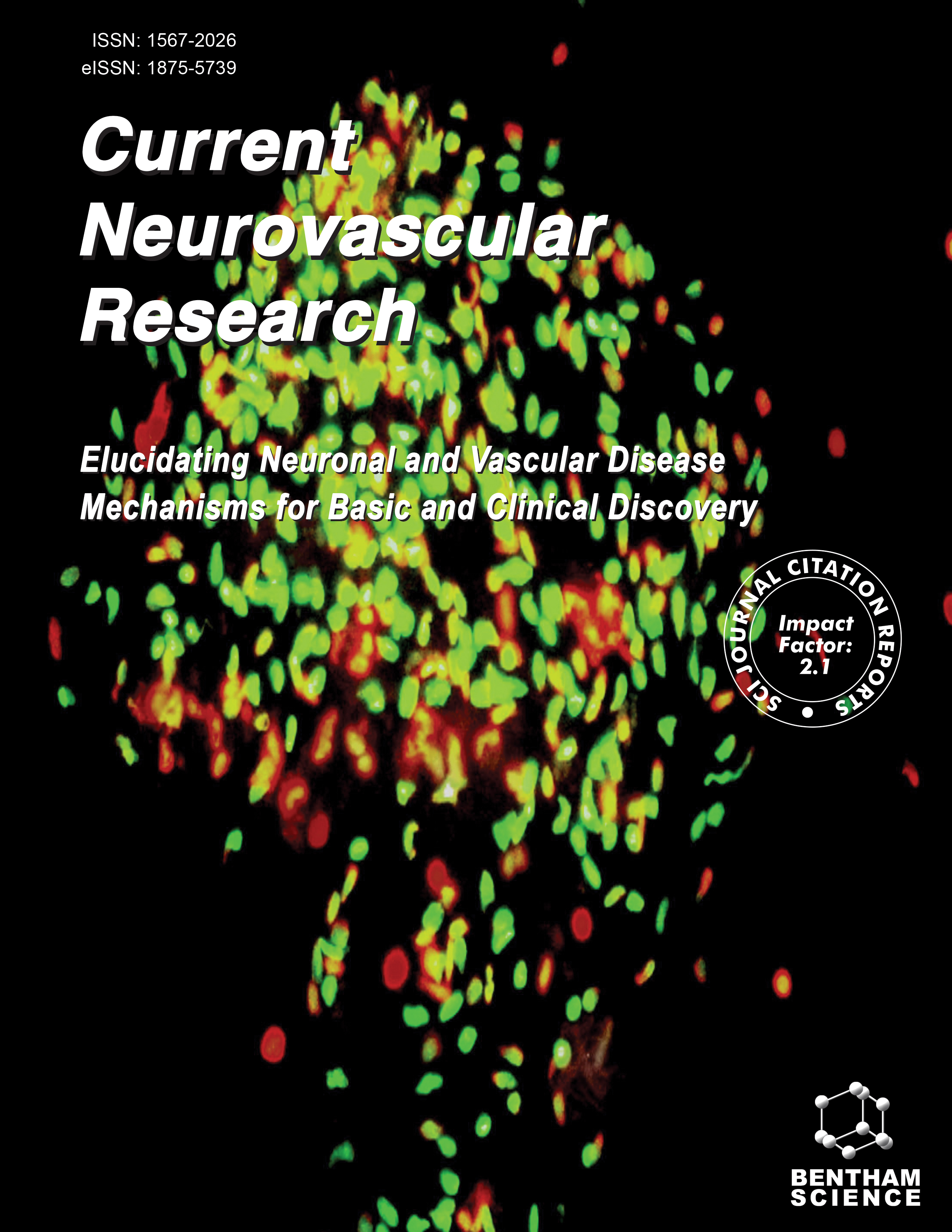- Home
- A-Z Publications
- Current Neurovascular Research
- Previous Issues
- Volume 4, Issue 2, 2007
Current Neurovascular Research - Volume 4, Issue 2, 2007
Volume 4, Issue 2, 2007
-
-
Experimental Models of Discovery: Prediction and Protection must Proceed “Hand-in-Hand”
More LessWith the continued expansion of medical technologies and new strategies for human disease, we can sometimes fall prey to the belief that successful clinical therapies will consistently employ the desired attributes of safety and efficacy as common denominators. Yet, even for some remarkable and presumably safe diagnostic techniques such as magnetic resonance imaging, these assumptions may fall short of our a Read More
-
-
-
Establishment of Cholinergic Neuron-like Cell Lines with Differential Vulnerability to Nitrosative Stress
More LessAuthors: David A. Personett, Katrina Williams, Karen A. Baskerville and Michael McKinneyCholinergic cell lines were established by fusion of embryonic day 17 wild-type neurons from rat basal forebrain (BF) and upper brainstem (BS) with N18tg neuroblastoma cells. Isolated clones expressed choline acetyltransferase (ChAT) and neuronal nitric oxide synthase (nNOS) activities that were increased upon differentiation with retinoic acid. Clones from the BF expressed high levels of the tyrosine kinase type A (TrkA) rece Read More
-
-
-
Preconditioning with Chronic Cerebral Hypoperfusion Reduces a Focal Cerebral Ischemic Injury and Increases Apurinic/Apyrimidinic Endonuclease/Redox Factor-1 and Matrix Metalloproteinase-2 Expression
More LessAuthors: Sun-Ah Choi, Eun Hee Kim, Jong Yun Lee, Hyo Suck Nam, Seo Hyun Kim, Gyung Whan Kim, Byung In Lee and Ji Hoe HeoAtherosclerosis may cause severe stenosis of the arteries supplying the brain, which induces chronic cerebral hypoperfusion. Although an infarction often occurs in the chronically hypoperfused brain area, it has been uncertain whether the stroke severity is attenuated or increased when further decrease of blood flow occurs. To test the hypothesis that chronic cerebral hypoperfusion is protective against the subsequent severe is Read More
-
-
-
Current Advances in the Treatment of Parkinson's Disease with Stem Cells
More LessAuthors: Katarzyna A. Trzaska and Pranela RameshwarStem cell replacement has emerged as the novel therapeutic strategy for Parkinson's disease (PD). Control of motor behavior is lost in PD due to the selective degeneration of mesencephalic dopamine neurons (DA) in the substantia nigra. This progressive loss of DA neurons results in devastating symptoms for which there is no cure. Debilitating side effects often result from chronic pharmacological treatment, hence c Read More
-
-
-
The Zebrafish Model: Use in Studying Cellular Mechanisms for a Spectrum of Clinical Disease Entities
More LessAuthors: Chi-Hsin Hsu, Zhi-Hong Wen, Chan-Shing Lin and Chiranjib ChakrabortyAlthough the zebrafish model provides an important platform for the study of developmental biology, recent work with the zebrafish model has extended its application to a wide variety of experimental studies relevant to human disease. Currently, the zebrafish model is used for the study of human genetic disease, caveolin-associated muscle disease, homeostasis, kidney development and disease, cancer, cardiovascular diso Read More
-
-
-
Role of Ischemic Blood-Brain Barrier on Amyloid Plaques Development in Alzheimer's Disease Brain
More LessThis review demonstrated that ischemic brain injury induces chronic changes in blood-brain barrier in the gray and white matter. This insufficiency of blood-brain barrier may allow entry of uncellular blood components such as different fragments of amyloid precursor protein and cellular blood components like leukocytes and platelets into the brain parenchyma. These blood components may have chronic harmful effects on the Read More
-
-
-
Microglial Signal Transduction as a Target of Alcohol Action in the Brain
More LessBy Kyoungho SukAlthough alcohol is believed to exert deleterious effects on the nervous system in general, its specific effect on the brain's immune system remains poorly understood. In particular, the effects of alcohol consumption on the immune and inflammatory responses in the central nervous system (CNS) have not been extensively investigated. Here, reviewed is the recent progress on how ethanol influences the signal transduction p Read More
-
-
-
The Role of Neurotrophins in Axonal Growth, Guidance, and Regeneration
More LessNeurotrophins are proteins that regulate neuronal survival, axonal growth, synaptic plasticity and neurotransmission. They are members of the neurotrophic factors family and include factors such as the nerve growth factor (NGF), the brain derived neurotrophic factor (BDNF), the neurotrophin-3 (NT-3), and the neurotrophin-4/5 (NT-4/5). These molecules bind to two types of receptors: i) tyrosine kinase receptors (T Read More
-
Volumes & issues
-
Volume 21 (2024)
-
Volume 20 (2023)
-
Volume 19 (2022)
-
Volume 18 (2021)
-
Volume 17 (2020)
-
Volume 16 (2019)
-
Volume 15 (2018)
-
Volume 14 (2017)
-
Volume 13 (2016)
-
Volume 12 (2015)
-
Volume 11 (2014)
-
Volume 10 (2013)
-
Volume 9 (2012)
-
Volume 8 (2011)
-
Volume 7 (2010)
-
Volume 6 (2009)
-
Volume 5 (2008)
-
Volume 4 (2007)
-
Volume 3 (2006)
-
Volume 2 (2005)
-
Volume 1 (2004)
Most Read This Month
Article
content/journals/cnr
Journal
10
5
false
en


